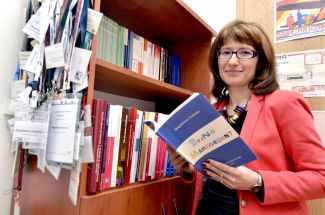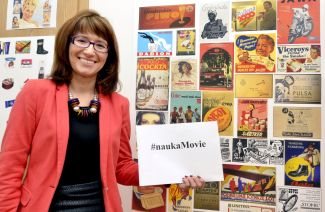Marketing specialists appeal to consumer emotions to increase the effectiveness of advertising campaigns. One of the mechanisms they use is to evoke positive associations that hark back to our childhoods and youth. And this is exactly what TUL's scientists have been researching. They received a grant from the National Science Centre (NCN) funding scheme OPUS to carry out an international research project "Nostalgia in brand management".
What determines consumer purchasing decisions?

Many factors influence purchasing decisions. They include, among others, the culture you grow up in, where you come from, your educational attainment, your financial situation. However, the key factor is the product itself - its price, type, brand (is it well-known or not), packaging. The place where we complete our purchase is also quite significant because the ambience of the store stimulates our behaviour. Vendors use sensory marketing, which means they take care to ensure ambient temperature, music and scent at the store. They use these tricks to woo us into making a purchase. As consumers, we are not aware of the role all these factors play and, in effect, our behaviour is not only rational but irrational, too. When we make a purchase based on our need or desire we identified, we act rationally. However, when what drives us is imitation, running with herd or we act on impulse, our behaviour is irrational. As for emotions experienced by consumers, they fall into two categories. Positive emotions, e.g. joy of making a purchase, the desire to pamper yourself, and negative ones such as annoyance, irritation at not being able to find the product you are looking for or the store being too busy.
How is "nostalgia" construed in the context of marketing?
Contrary to the generally accepted definition of nostalgia perpetuated, say, in belles-lettres where nostalgia represents an overwhelming longing, most frequently for one's homeland, in marketing, the concept tends to have quite positive connotations. In marketing, nostalgia is defined as a favourable consumer attitude towards people, places, products and brands that they remember from the times when they were young. What young means depends on the age of individual consumers. For older people, it may mean the period of early adulthood, for adults it may mean adolescence, and for young people - their childhood. It could even mean the good old times as remembered by our grandparents. Knowing a scent, a taste or even a store where you could get the best products from stories alone suffices to induce associations that evoke nostalgic attitudes.
What are the objectives of the project 'Nostalgia in brand management' carried out under the NCN funding scheme?

We aim to determine the significance and the possibility of taking advantage of nostalgia phenomenon in brand management. It is also our task to identify and gauge consumer attitudes towards nostalgic brands in relation to product category and demographic profile of consumers. In the project, in line with international literature, we have differentiated generational and multigenerational brands. Generational brands are all about real nostalgia linked to our own individual experiences or collective memories, e.g. of Christmases past or summer holidays. Multigenerational brands on the other hand are based both on real nostalgia, experienced by many generations, and simulated nostalgia that relates indirectly to experiences lived through by our parents or grandparents. We are carrying the project out together with scientists from the French Université Paris-Est and thus, we will be comparing attitudes that young consumers in Poland and in France have towards international nostalgic brands such as Nintendo, Coca - Cola and Nutella.
What can you tell us about the initial results of your research?
We have already identified generational and multigenerational nostalgic brands typical for Poles. Currently, we are in the process of assessing consumer attitudes to these brands. Next, we are going to compare consumer attitudes towards the selected nostalgic and non-nostalgic brands. The nationwide study in Poland is performed with a representative sample of 1 000 legal age respondents. The first stage, which is identification of nostalgic brands, has already been completed. The most popular mutigenerational brands were Fiat, Wedel, Wawel, Romet, Adidas, Bambino and Coca-Cola. As for generational brands, the youngest respondents indicated Frugo and Milky Way; their parents' generation pointed to Polar, Zelmer, Levis. The generation of grandparents named Biały Jeleń, Krakus, Pani Walewska, and Syrenka. Only brands that are still marketed today qualified for the study. Given our prior survey experience, we were genuinely surprised by the positive response we got from the respondents. People tend to be forthcoming about the brands that they associate with their childhood, and youth. They ask extra questions and are interested to know when and where the results of the study will be available.
Vendors' sales strategies are driven by anticipated profits. What does campaign design look like from their point of view? What mechanism do they employ to effect consumer behaviour that they are after?

Further in the project, we want to study corporate activity. We aim to identify the methods of building and developing nostalgic brands. We have noticed, however, that nostalgic brands' product ads are based on story-telling, on stories based on a specific narration, on introducing certain codes, symbols, historical elements into brand identity so as to reinforce consumer attitudes. Corporate activity is not limited to marketing communication. Companies re-launch products they used to sell in the past, retro-package them too, e.g. Wedel and Coca - Cola.
Can nostalgia be used to advertise any product group?
The mechanism can be used for different product groups, for example automotive. Here, we could speak of a retro-innovation paradox where, in the same advertisement, advanced technological solutions are juxtaposed with references to traditions. It would seem that automotive industry should concentrate exclusively on innovation, and yet, as VW and Fiat campaigns have shown, exploiting simulated nostalgia to build a brand really pays off.
Which of the advertisements that you have studied would you consider perfect in terms of its emotional appeal?
It would have to be one of the Fiat ads from a few years ago when Fiat 500 was being re-released. Marketing communication referred to momentous events in the histories of the nations where the spots where broadcast (glocalization). The idea behind all commercials was the same - a young boy watching a movie that showed important events in the history of his nation with Fiat as a feature of this history. However, each spot was fine-tuned to the specific nation: Poles, Italians, the French. In Poland, the commercial featured Fiat 125p, Solidarity movement, John Paul II and Zbigniew Boniek.
It is worth being a scientist because...

… it is more than a job. A scientists does not fit a typical description of a profession. Because I am a scientists, everyday, I have the opportunity to explore the world around me and look for answers to thought-provoking questions. And I have a chance to share my findings with others.
